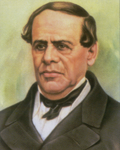Background
Political instability and interim presidencies
In 1853, Mexico was facing political and military instability due to ongoing economic and military challenges, exacerbated by the Mexican-American War and political tensions between conservatives and liberals. Mariano Arista resigned on January 5 due to his failure to address these issues, and the Supreme Court appointed Juan Bautista Ceballos as interim president. However, Ceballos’ term lasted only from January 5 to February 8 due to his inability to resolve the crises, leading to his resignation. [4] Manuel María Lombardini succeeded Ceballos as interim president from February 8 to April 20, 1853. Lombardini, like his predecessor, struggled with unrest, particularly from military factions and conservatives, and resigned after his failure to restore stability. [5] [4]
Santa Anna's return to the presidency
Antonio López de Santa Anna eventually returned to power through the Plan of Hospicio [ es ], a political maneuver supported by conservative factions and military leaders. His return was facilitated by a decree, not a formal election. The number of votes in favor of the plan is unknown, as there was no formal voting process. As a result, Santa Anna's return was more a political arrangement than a democratic election. [5]
This page is based on this
Wikipedia article Text is available under the
CC BY-SA 4.0 license; additional terms may apply.
Images, videos and audio are available under their respective licenses.

